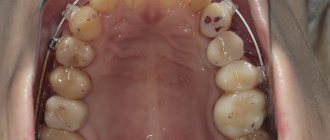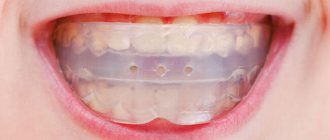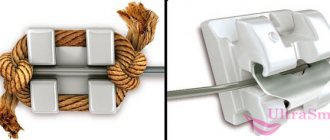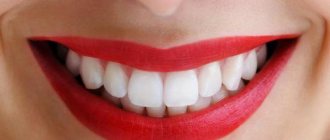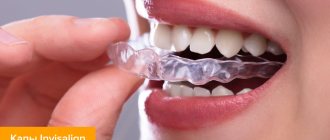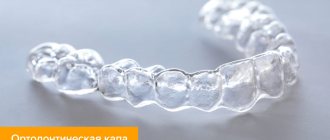- Development of headaches and discomfort when moving the jaw.
- Uneven or excessive grinding of teeth.
- Frequent caries even with proper and regular oral care.
- Incorrect jaw position, changing the shape of the face and worsening appearance.
- Psychological problems due to embarrassment when smiling.
Since not all children can be fitted with full-fledged braces, it is necessary to use alternative means.
Among the most popular and effective are children's mouthguards for correcting bites. At the Novodent clinic, we are ready to accept small patients with their parents, answer all their questions and begin effective bite correction.
Mouth guards as an alternative to braces
Straightening crooked teeth, of course, should be done in childhood. However, many parents simply do not pay attention to this problem. Therefore, the question of orthodontic treatment for most patients arises in adolescence or adulthood. However, not every teenager or adult will agree to put braces on their teeth and follow not the most simple rules of hygiene. Until recently, there was no alternative to braces. But with the advent of aligners - mouth guards for straightening teeth, it became possible to undergo orthodontic treatment unnoticed by others and with comfort for yourself. Moreover, this applies not only to adults, but also to teenagers, for whom their own technology of transparent mouth guards has been developed. Like aligners for adults, they are a set of removable aligners, completely invisible to others, which can correct most dental anomalies, provided that the attending physician has the appropriate experience.
Features of a mouth guard for teeth straightening
Removable aligners for teeth straightening for adults are made from a special transparent material. Today, their range of applications is no different from the capabilities of braces, but treatment with mouth guards is much easier and more enjoyable. The main advantage of the system is that they are not visible, whereas braces, whether sapphire or ceramic, are still visible on the teeth. Of course, there are also lingual invisible braces, which are attached to the teeth from the inside, but they have a fairly long period of adaptation, just like other brace systems. Typically, it takes several weeks for the patient to adapt to braces, during which it will be uncomfortable for the wearer to eat and talk. In addition, braces, like other types of mouth guards, rub the mucous membrane and “scratch” the teeth, which causes some discomfort. But correcting a bite with a mouth guard is as comfortable as possible for patients.
Types of mouth guards
- Invisalign aligners Innovative clear aligners for correcting malocclusion in adults. The set consists of two separate trays with cells for teeth
- Trainers Double-jawed transparent mouthguard, which is used to treat children
The devices can be plastic or silicone. They also differ in the manufacturing principle - there are standard and individual ones. In the first case, this is a standard mouthguard that does not take into account the structure of the jaw. They can be used for correction in children. In the second case, the design is made based on a cast of your dentition.
Transparent mouth guard for teeth straightening and trainers
Dental aligners for straightening teeth are often confused with trainers and retainers, which are worn after braces are removed. Meanwhile, these are completely different orthodontic devices, which have different indications for use and have different effects on the dental system. Trainers are somewhat reminiscent of sports mouthguards to protect teeth from impacts. With their help, it is possible to correct malocclusion and dental position in children from three years of age, which have developed as a result of impaired breathing and swallowing functions, as well as due to numerous childhood bad habits, such as prolonged sucking of a pacifier or bottle. Trainers are particularly effective for treating early stage malocclusions and are therefore mainly suitable for children under 11 years of age. A retainer is usually prescribed to consolidate the results of orthodontic treatment and adjust muscle function in accordance with the bite. It is bulkier than a clear aligner for adults and is made of flexible silicone.
How the aligners work
Aligners are custom-made, removable, thin, clear plastic trays molded to the shape of the dental arch that the orthodontist seeks to create. This is a mirror of the future of your bite - what it will look like in 2 weeks. They move the teeth into the desired position.
To do this, first an impression is taken from the patient's jaws and a plaster cast is created. The aligner is then created using special 3D modeling software.
How long does it take to make aligners?
Based on the created 3D simulation, the required number of pairs of mouthguards are manufactured and sent to you within a few weeks.
The aligners move the teeth in controlled steps and very gently. Each individual tray applies slight pressure to the teeth and thereby moves them into the desired position. At the beginning of each phase, patients usually feel a slight pressure, but after a few days the sensation disappears.
Depending on the course of treatment, you will receive from 3 to 9 pairs of aligners. They are changed every 2-3 weeks. Unlike braces, mouthguards do not have adjustable elements. Instead, new designs are created for each individual stage of treatment.
How long should you wear aligners to straighten your teeth?
The course of bite correction with mouth guards lasts on average from 9 to 18 months. The duration of treatment and the timing of wearing aligners depend on the degree of required tooth displacement and the individual plasticity of the patient’s bone tissue.
Is it possible to correct an overbite with aligners?
Only an orthodontist can definitely say whether aligners will help with a malocclusion, and only after an examination, a full examination and special calculations. Aligners are often used for minor orthodontic pathologies, and whether the aligners will correct the bite in your particular case will become known only after a comprehensive examination and an accurate diagnosis. The main use of these structures is correction and fixation after a course of treatment with braces.
What do aligners fix?
Treatment with plastic splints is possible for both mild and severe forms of incorrect position of the teeth and the entire bite.
The following pathologies can be corrected with the help of orthodontic aligners:
- Crowding of teeth: When there is a lack of space in the jaw, it causes the teeth to move in different directions, tilt and turn out. Due to the grouping of teeth and their incorrect position, gingivitis, periodontitis, and caries often develop; Oral hygiene becomes significantly more difficult.
- Wide gaps between teeth occur when the jaw is large and the teeth are naturally small or some of them are lost.
- Crossbites and reverse bites are pathologies of teeth closure, in which misalignment and incorrect overlap of some teeth with others occurs. This leads to the occurrence of periodontal diseases, faster wear of teeth and their forced early loss.
- A deep bite is a variant of pathological occlusion in which the teeth of one jaw overlap with others too much. This leads to frequent injuries, the development of periodontal disease and even more severe tooth displacement.
- Incorrect position of individual teeth: there are violations of the placement and position of teeth, such as tilting, rotation (turning around its axis), displacement in one direction or another.
Are there any contraindications to treating malocclusion with aligners?
There are no strict contraindications for the use of these drops. The main thing is to keep your teeth and gums healthy. Before correcting the bite, sanitation of the oral cavity is always carried out: treatment of caries and its complications, acute inflammatory processes, professional hygiene - all this will ensure a good prognosis for orthodontic treatment and increase the effectiveness of the aligners.
Silicone aligners for teeth straightening
Treatment with clear aligners minimizes the risk of medical error. The fact is that while wearing braces, the dentist takes a very active part and is independently involved in their installation and corrections, and in the process he may make a mistake. As a result, the course of treatment and, as a consequence, its outcome may be disrupted. In addition, during the next correction, there is a risk of “tightening” the ligature, which can cause severe pain and “eversion” of the roots of the teeth. A transparent mouthguard for straightening teeth for adults acts on hard tissues very smoothly and, if the doctor initially correctly calculated the trajectory of teeth movement, cannot disrupt the course of treatment.
Plastic mouth guards for straightening teeth in teenagers
Despite all the advantages of plastic mouthguards, many people consider removable designs inappropriate for teenagers. The biggest concern of orthodontists and parents regarding orthodontic treatment with aligners is that the patient will constantly remove the appliance, and the entire treatment will go down the drain. The fact is that to achieve the desired effect, the structure must be on the teeth for at least 20 - 22 hours a day. Not all adults follow this immutable rule, let alone teenagers. For peace of mind, you can choose removable mouth guards for straightening teeth in teenagers with an indicator that changes color depending on how many hours the patient has been wearing it. If a teenager has worn a mouthguard too little, the indicator will show this.
Night guard for straightening teeth
Imagine that there is a design for correcting your bite, which you only need to wear at night. It does not require any additional care other than simple cleaning once a day. Thus, it does not interfere with work, communication, eating and does not cause discomfort. Intrigued? We hasten to disappoint you. Unfortunately, nothing like this has yet been invented. But it’s hard not to agree that if a night guard existed, it would, without a doubt, be considered the most convenient to use and enjoy overwhelming success. However, correction of dental anomalies is a complex process that involves exposure to teeth over a certain period of time, and wearing aligners for less than 20 hours a day, unfortunately, will not be effective.
However, among the arsenal of orthodontic devices there are still devices that need to be worn only at night. They are called removable retainers and are used to consolidate the results after treatment with braces. The teeth do not immediately “get used” to the new position, so they often strive to return to their original position. Retainers prevent them from doing this and help keep their teeth perfectly straight.
Installing a mouthguard to straighten teeth
Aligners are much easier to install than braces, and they are also much more comfortable to wear and adjust. This procedure usually takes place in 3 stages.
- Diagnostics.
The doctor examines the patient for contraindications and diseases that must be eliminated before starting treatment. An accurate cast of the jaw is then made, which will serve as the basis for creating the mouthguards. - Manufacturing.
All data - x-ray, tomogram, jaw model - are sent to the company’s laboratory and processed in a special program. After this, a special device produces the required number of aligners to straighten the teeth. - Installation.
A person receives a set of products and recommendations for use. The specialist helps you put on the device, prescribes medications if necessary, and then sets a date for the next appointment. You will have to visit the orthodontist only once every one and a half to two months to monitor changes. The aligners do not require correction; the dentition is corrected by changing the set every two weeks.
About the duration of wearing a mouth guard and basic care methods
The question of the duration of treatment is individual and depends on the complexity of the defect and the degree of malocclusion in the child.
The average duration of treatment is from 10 to 24 months.
There are a few simple recommendations for mouthguard care that you should follow:
- Each product is supplied in a special container. It must be stored there permanently.
- You cannot use aligners with various types of defects - chips, cracks and others.
- After you remove the tray, you need to rinse it in cold water.
- In the mornings and evenings, you can wash the mouth guard with soapy water. Only soft brushes are suitable for cleaning - you should take care of purchasing in advance.
Remember the need to maintain the cleanliness of such a product - the child’s health will depend on this. Most manufacturing materials do not tolerate temperature changes well.
Does a mouthguard help straighten teeth?
The principle of operation of aligners is almost the same as that of braces - moving teeth into the correct position by applying pressure to them, but the impact of aligners is much gentler. An additional advantage is that this orthodontic design does not require correction; alignment occurs by changing sets.
In general, the effectiveness of aligners directly depends on production technology and a correctly drawn up treatment plan. Some manufacturers openly declare that their product can completely replace braces. Other brands correct both complex and simple dental anomalies, but indicate certain restrictions on indications. These details are always listed on the company’s website and, as a rule, are known to orthodontists.
However, there is one significant caveat. Even if you choose a reliable manufacturer and find a good specialist, the procedure will not give the expected result if you wear the product less than 20 hours a day and do not follow the doctor’s recommendations.
Advantages and disadvantages of technology
Among the important advantages of the technology are the following:
- Comfortable to wear. Children usually quickly get used to this need.
- Harmlessness. By using high-quality materials, you will not damage your teeth or gums.
- Easy to care for. The mouth guard will only need to be cleaned periodically.
- Noticeable result. The bite is truly corrected, and it helps many children avoid the much more difficult wearing of braces.
- Possibility to remove the mouthguard. This allows you not to limit yourself in the foods you eat and brush your teeth normally.
At the same time, the child will not have to worry about his diction being impaired - the mouthguard can be worn at night or when he is at home. The technique differs favorably from braces in its ease of care and significantly lower likelihood of oral diseases. The production uses completely safe materials that do not cause allergies.
But it is worth remembering the disadvantages. So the price of a mouthguard for a child may seem high to many. This option is not suitable for everyone. For example, if the baby has complex defects, they will have to be corrected in other ways.
How much do teeth straightening trays cost?
Aligner aligners are one of the most expensive methods of bite correction, but their cost is fully justified by the effect and comfort of use. It is important to note that you should not trust manufacturers who immediately name a fixed amount - you can find out the full cost only after an examination and consultation with an orthodontist. Based on the complexity of the problem, the specialist will draw up a treatment plan, which will indicate the number of mouth guards required for this particular case, the frequency of visits to the doctor and additional structures. These criteria determine the final cost of treatment. All manufacturers of aligners must explain in detail to patients what factors affect the price of the product.
Advantages of caps
- Transparent and invisible when smiling – feel free to communicate
- Keep the enamel healthy - with proper care, mouthguards do not affect the condition of the teeth at all
- Individual production - created from impressions taken from your dentition
- Quick addiction - after 10-15 minutes you will forget about the existence of the mouth guard
- They treat soft tissues with care - the soft design does not injure the gums
- Easy to maintain - can always be removed to wash
